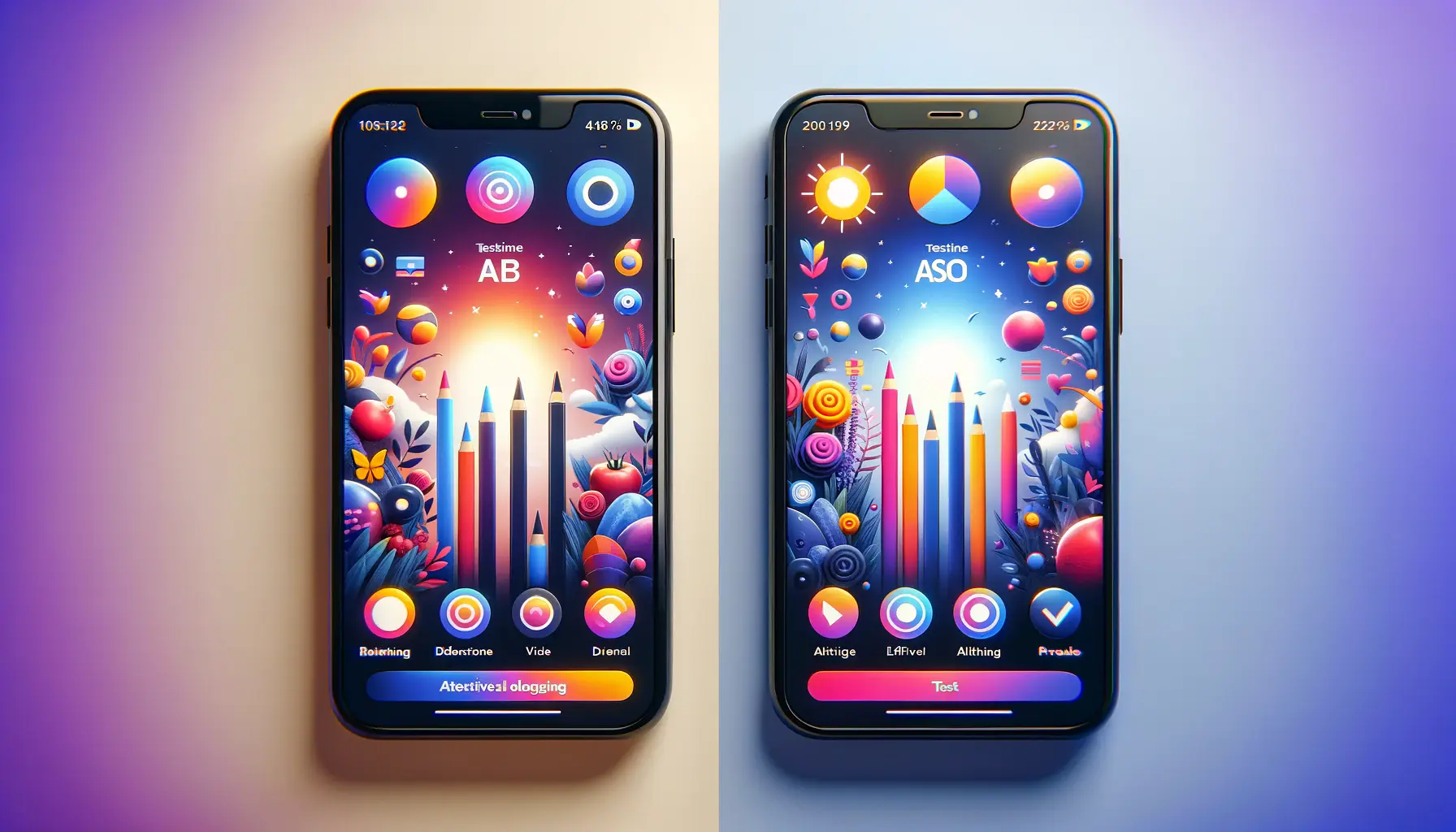The art and science of App Store Optimization (ASO) have become crucial in the digital marketplace.
ASO not only enhances app visibility within app stores but also significantly impacts the user’s decision to download.
Among the various elements that contribute to an effective ASO strategy, screenshots stand out for their immediate visual impact on potential users.
This article delves into the intricacies of optimizing ASO screenshots, aiming to offer valuable insights into leveraging visual appeal for improved app performance.
The role of screenshots in ASO cannot be overstated.
They are not just decorative elements but strategic tools that convey the essence of your app to the audience.
With the right approach, screenshots can narrate your app’s functionality, appeal, and unique selling propositions, all within a few seconds of glance time.
Understanding and analyzing the performance of your ASO screenshots is thus a pivotal step towards achieving higher download rates and better app market standings.
- Understanding ASO Screenshot Dynamics
- Optimizing Screenshots for Visual Impact
- Highlighting User Experience and Social Proof
- Maximizing Visibility with Keyword Optimization
- Employing Composition and Layout for Clarity
- Tracking and Analyzing ASO Performance
- Adapting to Market Trends and User Feedback
- Conclusion: Mastering ASO Through Strategic Screenshot Optimization
- FAQs on ASO Screenshot Optimization
Understanding ASO Screenshot Dynamics
The dynamics of ASO screenshots revolve around the visual hierarchy, composition, and the psychological impact they have on potential users.
A well-structured visual hierarchy ensures that key information is immediately accessible, guiding the viewer’s attention to where it’s most impactful.
The composition of these screenshots, including the use of color, text, and imagery, plays a significant role in communicating the app’s value proposition effectively.
Psychologically, humans are wired to process visual information much quicker than text.
This means the first impression made by your screenshots can significantly influence the decision-making process of the user.
The challenge lies in creating screenshots that are not only visually appealing but also informative and reflective of the user experience your app offers.
Through meticulous planning and design, screenshots can become powerful conversion tools in your ASO strategy.
Key Components of Effective Screenshots
To optimize your ASO screenshots for better performance, several key components must be considered.
First, the visual appeal of your screenshots should align with your app’s branding and user expectations.
This includes using consistent color schemes, typography, and imagery that resonates with your target audience.
Secondly, clarity is paramount.
Screenshots should be easily understandable, with legible text and clear depictions of the app’s features or benefits.
Incorporating social proof, such as user testimonials or ratings within your screenshots, can also enhance credibility and attract more downloads.
Lastly, optimizing screenshots for different user segments can lead to increased engagement.
Tailoring visual content to match the preferences of specific demographics, locations, and even devices ensures your app appeals to a broader audience.
Employing these strategies effectively can make a significant difference in how your app is perceived and ultimately, its success in the app store.
It’s essential to view your ASO screenshots as more than just pictures. They are a visual pitch to your potential users, encapsulating the essence of your app in a few compelling frames. Every pixel should serve a purpose, from highlighting key features to demonstrating the app’s real-world application. The ultimate goal is to intrigue, inform, and invite users into the unique world your app creates.
Optimizing Screenshots for Visual Impact
Creating screenshots that make a lasting impression involves more than just showcasing app features; it’s about telling a story that resonates with your audience.
A strategic approach to visual optimization can significantly enhance the impact of your ASO screenshots, ensuring they capture the essence of your app and encourage downloads.
The optimization process should begin with a deep understanding of your target audience.
This includes knowing their preferences, the problems they seek to solve with your app, and how they interact with apps in your category.
With this insight, you can craft screenshots that not only attract attention but also speak directly to the needs and desires of your potential users.
Designing for User Engagement
To design ASO screenshots that drive user engagement, consider the following elements:
- Emotionally Resonant Imagery: Use visuals that evoke emotions or tell a story. This can significantly increase the likelihood of a user stopping to learn more about your app.
- Feature Highlight: Clearly showcase the core functionalities of your app. If your app solves a problem, show it in action, addressing that specific issue.
- Branding: Incorporate your app’s branding elements, such as logo, color scheme, and typography, to ensure consistency and recognition.
Moreover, the orientation and size of your screenshots can affect their visibility and appeal.
Testing different formats to see which ones engage your audience the most can provide valuable insights for optimization.
Utilizing A/B Testing
A/B testing plays a crucial role in optimizing ASO screenshots for performance.
By creating variations of your screenshots and testing them in the market, you can gather data on what resonates best with your audience.
Consider testing different visual elements such as:
- Colors and contrast
- Typography and text placement
- Image composition and layout
- Presence of social proof elements (ratings, reviews)
This iterative process allows you to refine your screenshots based on actual user feedback and engagement metrics.
Remember, the goal is not just to attract views but to convert viewers into users by compelling them to download your app.
Effective screenshot optimization is an ongoing process. Regularly updating and testing your ASO visuals can keep your app relevant and appealing to new users, adapting to changing market trends and user preferences.
Highlighting User Experience and Social Proof
Integrating elements that showcase the user experience and incorporating social proof are strategies that can substantially elevate the perceived value and trustworthiness of your app through ASO screenshots.
Demonstrating the real-life application and satisfaction of current users can make your app more relatable and desirable to potential users.
ASO screenshots that effectively highlight the user experience and social proof engage potential users by showing them what they can expect from using the app.
This transparency not only builds trust but also helps in setting realistic expectations, which is crucial for long-term user retention.
User Experience Representation
To convey a compelling user experience in your screenshots, consider the following strategies:
- Use Real-life Scenarios: Showcase your app’s usage in everyday situations that potential users can relate to. This approach helps in illustrating the app’s practical value.
- Feature Benefits Over Features: Instead of just listing app features, focus on how these features benefit the user. Highlighting benefits can more effectively communicate the app’s value proposition.
When potential users see your app in action, solving problems or enhancing daily life, they are more likely to consider downloading it.
Visualizing the user experience in ASO screenshots can significantly influence the decision-making process of the audience.
Incorporating Social Proof
Social proof can be a powerful tool in your ASO strategy, helping to build credibility and trust among potential users.
Including elements of social proof in your screenshots, such as user testimonials, ratings, and awards, can have a positive impact on download rates.
Here’s how you can incorporate social proof into your ASO screenshots:
- User Testimonials: Feature short, impactful testimonials from satisfied users. Choose reviews that highlight the app’s strengths and how it has positively affected users.
- Ratings and Awards: Display your app’s ratings and any awards or recognitions it has received. High ratings and awards serve as endorsements of your app’s quality and popularity.
By leveraging social proof in your screenshots, you’re not only telling potential users that your app is worth downloading but also providing evidence to support this claim.
This can make a significant difference in a highly competitive app marketplace.
Remember, showcasing the user experience and incorporating social proof in your ASO screenshots can transform them from mere images into powerful narratives that engage, convince, and convert potential users into loyal customers.
Maximizing Visibility with Keyword Optimization
Keyword optimization plays a pivotal role in enhancing the visibility of your app within app stores.
Incorporating relevant keywords into your ASO strategy, including screenshots, can significantly improve your app’s searchability, making it easier for potential users to find your app.
Understanding how to effectively integrate keywords into your visual content and descriptions is essential for driving organic app downloads.
While screenshots are primarily visual elements, the accompanying text and metadata provide an opportunity to include keywords that target your audience.
This integration should be natural and focused on providing value, rather than simply stuffing keywords into descriptions.
Strategic Keyword Placement
To maximize the effectiveness of keyword optimization in your ASO screenshots, consider these strategies:
- Title and Subtitle Incorporation: Use your app’s title and subtitle to include primary keywords. These are often the first elements read by potential users, making them crucial for impressions.
- Description Optimization: Craft compelling descriptions for your screenshots that incorporate keywords naturally. These descriptions should explain the screenshot while also enhancing your app’s discoverability.
Remember, the goal is to make your app more visible to those actively searching for solutions or experiences your app provides.
Effective keyword optimization requires ongoing analysis and adjustment based on performance metrics and evolving market trends.
Researching and Selecting Effective Keywords
Finding the right keywords involves understanding your target audience, the competitive landscape, and current trends.
Use these guidelines to select keywords:
- Analyze your target audience’s search behavior to identify the terms and phrases they use when looking for apps like yours.
- Study competitors to discover which keywords they are targeting and identify any gaps in their strategies.
- Utilize keyword research tools designed for ASO to gather data on keyword volume, difficulty, and effectiveness.
Integrating these keywords into your ASO strategy, including screenshot captions and metadata, can help improve your app’s visibility and attract a more targeted user base.
Keep in mind that the app marketplace is dynamic, requiring you to periodically review and adjust your keyword strategy to maintain and improve your app’s ranking and visibility.
Effective keyword optimization is more than just a one-time setup; it’s an ongoing effort that needs to adapt to changes in user behavior and competitive dynamics. Regularly revisiting your keyword strategy can ensure your app remains visible and appealing to your target audience.
Employing Composition and Layout for Clarity
The composition and layout of ASO screenshots are crucial for conveying your app’s functionalities and appeal with clarity and impact.
An intelligently designed layout not only captures attention but also facilitates a smoother user journey through visual storytelling.
By optimizing the composition, developers can guide potential users’ eyes to the most important elements, enhancing their understanding and interest in the app.
Effective layout strategies involve more than just aesthetically pleasing arrangements; they serve to highlight the app’s benefits and features in a way that is immediately understandable.
This requires a careful balance of elements, ensuring that each screenshot is informative yet not overcrowded or confusing.
Design Principles for Effective Layouts
To create ASO screenshots that are both visually appealing and communicative, consider these design principles:
- Visual Hierarchy: Use size, color, and placement to establish a focal point in your screenshots. Highlight key features or calls to action that guide the user’s understanding of your app.
- Simplicity and Clarity: Avoid clutter by focusing on the essentials. Use negative space effectively to make your screenshots more readable and to prevent information overload.
The arrangement of elements within each screenshot should tell a part of your app’s story, leading potential users through a curated experience that showcases the app’s value.
This narrative approach not only engages users but also aids in their decision-making process by providing clear insights into what the app offers.
Optimizing for Different Screen Sizes and Orientations
With a variety of devices and screen sizes available, optimizing your screenshots for different orientations and resolutions is essential.
This ensures that your visuals remain impactful and legible across all platforms.
Here are some tips for universal optimization:
- Test your screenshots on multiple devices to ensure visual elements are clear and legible, regardless of the screen size.
- Consider the aspect ratios and resolutions of different platforms when designing your screenshots to avoid distortion or cropping.
By employing strategic composition and layout, you can create ASO screenshots that not only stand out in the crowded app marketplace but also effectively communicate your app’s core value proposition.
This clarity and visual appeal can significantly influence potential users’ perceptions and actions, driving more downloads and engagement with your app.
A well-thought-out composition and layout strategy for your ASO screenshots can dramatically improve user engagement by making it easier for potential users to understand and appreciate the value of your app at a glance.
Tracking and Analyzing ASO Performance
Understanding the performance of your ASO strategy, particularly in relation to screenshots, is crucial for maintaining and enhancing your app’s presence in the app marketplace.
Tracking key performance indicators (KPIs) and analyzing the data collected can provide valuable insights into what works, what doesn’t, and where there are opportunities for optimization.
This continuous cycle of measurement, analysis, and adjustment is essential for keeping your app competitive and appealing to new users.
To effectively track and analyze your ASO performance, a comprehensive approach that considers various metrics and data sources is necessary.
This approach not only helps in assessing the direct impact of your screenshots but also in understanding broader user engagement and conversion trends.
Key Metrics for ASO Performance Analysis
Several metrics are particularly relevant for assessing the effectiveness of your ASO screenshots, including:
- Conversion Rate: The percentage of users who view your app’s store page and then proceed to download. A higher conversion rate indicates more effective screenshots.
- Click-Through Rate (CTR): Measures how often people who see your app in search results or featured listings click on it. A high CTR suggests that your screenshots are compelling and engaging.
Monitoring these metrics over time can help you identify trends, measure the impact of changes to your ASO strategy, and make data-driven decisions to improve performance.
Utilizing app store analytics tools and third-party ASO platforms can facilitate comprehensive performance tracking and analysis.
Implementing Changes Based on Insights
Armed with performance data, you can start making informed adjustments to your ASO screenshots and other elements of your strategy.
This might involve:
- Experimenting with different visual designs or messaging in your screenshots to see what resonates most with your target audience.
- Adjusting the order of screenshots to highlight the most compelling features or benefits upfront.
- Refining your keyword strategy based on which terms drive the most views and conversions to your app’s store page.
Remember, the goal of analyzing ASO performance is to continually refine your approach to better meet the needs and preferences of your target audience.
This iterative process can lead to sustained growth in app downloads and engagement, ensuring your app remains relevant and competitive in the dynamic app marketplace.
Assuming that a one-time optimization of your ASO screenshots will continuously yield positive results is a common mistake. The app market and user preferences are constantly evolving, requiring ongoing analysis and updates to your ASO strategy.
Adapting to Market Trends and User Feedback
In the rapidly changing landscape of the app marketplace, staying attuned to market trends and user feedback is imperative for the ongoing success of your app.
These insights not only inform the direction of your product development but also play a critical role in refining your ASO strategy, including the optimization of screenshots.
Adapting your approach based on these factors ensures that your app remains relevant, engaging, and visible to your target audience.
Market trends can indicate shifting user preferences, emerging technologies, or changes in app store algorithms, all of which can impact your app’s performance.
Similarly, direct feedback from users provides invaluable insights into their experiences, expectations, and desires.
Together, these inputs can guide you in making informed decisions to enhance your app’s appeal and functionality.
Leveraging User Feedback for ASO Enhancement
Collecting and analyzing user feedback is crucial for understanding how your app meets the needs of its users and where improvements can be made.
This feedback can come from various sources, including:
- App store reviews and ratings
- User surveys and interviews
- Social media and online forums
By paying close attention to user comments and concerns, you can identify areas for improvement not only in your app’s functionality but also in how it’s presented in the app store.
For example, if users frequently praise a specific feature in their reviews, highlighting this feature in your screenshots can make your app more attractive to potential users.
Keeping Pace with Market Trends
Staying informed about the latest market trends allows you to anticipate changes in user behavior and preferences, enabling you to adjust your ASO strategy accordingly.
This might involve:
- Introducing new features or content that align with current trends and highlighting them in your screenshots.
- Adjusting your app’s visual design to reflect modern aesthetics, making it more appealing to contemporary users.
- Updating your keyword strategy to include emerging search terms related to your app.
Adapting to market trends and user feedback is not just about maintaining your app’s relevance; it’s also about seizing opportunities to innovate and lead in your category.
By continuously refining your ASO strategy and product offerings, you can enhance user satisfaction, attract new users, and solidify your app’s position in the market.
Embracing change and being responsive to feedback are key to the long-term success of your app. Regularly updating your ASO screenshots and other elements based on user feedback and market trends can help you stay ahead of the competition and continue to grow your user base.
Conclusion: Mastering ASO Through Strategic Screenshot Optimization
Throughout this comprehensive exploration into optimizing ASO screenshots, we’ve delved into the multifaceted approach required to enhance app visibility, engage potential users, and ultimately, drive downloads.
The performance of your ASO screenshots is not just a measure of visual appeal but a reflection of strategic planning, user understanding, and market responsiveness.
By prioritizing these elements, developers can significantly improve their app’s market position and user acquisition rate.
Key Takeaways for ASO Success
Several key insights have emerged from our discussion on ASO screenshot optimization:
- The strategic use of visual hierarchy and composition can greatly influence user engagement and conversion rates.
- Incorporating user feedback and adapting to market trends are essential for maintaining the relevance and appeal of your app.
- Regularly tracking and analyzing ASO performance enables continuous improvement and adaptation to changing user behaviors and preferences.
These strategies underscore the importance of a dynamic and responsive approach to ASO.
The digital marketplace is ever-evolving, and so are the expectations of users.
Staying ahead in such an environment demands not just creativity and innovation but also an ongoing commitment to optimization and user satisfaction.
Enhancing App Performance Through Thoughtful ASO Practices
Ultimately, the goal of optimizing your ASO screenshots is to communicate the value and functionality of your app in the most compelling way possible.
This requires a deep understanding of your target audience, a keen eye for design, and an analytical approach to performance metrics.
It’s a process that combines art and science, intuition and data, to create a connection between your app and its potential users.
Remember, the journey towards ASO mastery is continuous.
As the app market evolves, so too will the strategies for capturing user attention and driving downloads.
By embracing a philosophy of constant learning and adaptation, developers can ensure their apps not only reach their target audience but also provide lasting value and enjoyment.
In conclusion, the performance of your ASO screenshots is pivotal in the competitive app marketplace.
By applying the insights and strategies discussed, developers can craft screenshots that not only capture attention but also convert viewers into loyal users.
This journey towards ASO excellence is one of constant evolution, requiring a commitment to innovation, user-centricity, and strategic optimization.
Embrace these principles, and watch as your app rises to new heights of success.
Boost your mobile app's success with our guaranteed App Store Optimization (ASO) service. Leave it to the experts!
FAQs on ASO Screenshot Optimization
Explore commonly asked questions about optimizing ASO screenshots to enhance your app’s visibility and user engagement.
ASO screenshots are vital as they provide a visual preview of the app, influencing users’ download decisions by showcasing key features and the user interface.
Incorporate vibrant colors, highlight key features with short, informative text, and use real-life scenarios to demonstrate the app’s value and usability.
While app stores allow different numbers, using 5-8 screenshots effectively showcases your app’s features and benefits, covering various use cases.
Indirectly, yes. Engaging screenshots can improve conversion rates, which in turn positively affects your app’s visibility and ranking in the store.
Update your screenshots with new app features, UI updates, or to reflect seasonal promotions, ensuring they always accurately represent your app.
Absolutely. A/B testing different screenshot variations helps identify what resonates best with your audience, optimizing engagement and conversions.
Yes, text captions can clarify screenshot visuals, highlighting benefits or features, making it easier for users to understand your app’s value proposition.
Analyze user search behavior and competitor keywords. Use tools for keyword research to find terms that are relevant and have high search volume.












